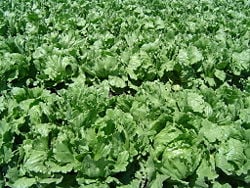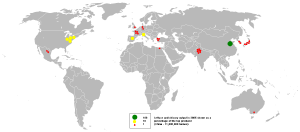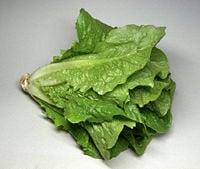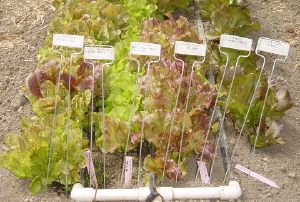Difference between revisions of "Lettuce" - New World Encyclopedia
({{Contracted}}) |
Katya Swarts (talk | contribs) |
||
| Line 1: | Line 1: | ||
{{Claimed}}{{Contracted}} | {{Claimed}}{{Contracted}} | ||
| + | {{Taxobox | ||
| + | | color = lightgreen | ||
| + | | name = Lettuce | ||
| + | | image = Iceberg lettuce in SB.jpg | ||
| + | | image_width = 250px | ||
| + | | image_caption = Iceberg lettuce field in Northern [[Santa Barbara County]] | ||
| + | | regnum = [[Plant]]ae | ||
| + | | divisio = [[Flowering plant|Magnoliophyta]] | ||
| + | | classis = [[Magnoliopsida]] | ||
| + | | ordo = [[Asterales]] | ||
| + | | familia = [[Asteraceae]] | ||
| + | | genus = ''[[Lactuca]]'' | ||
| + | | species = '''''L. sativa''''' | ||
| + | | binomial = ''Lactuca sativa'' | ||
| + | | binomial_authority = [[Carolus Linnaeus|L.]] | ||
| + | }} | ||
| + | {{nutritionalvalue | name=Lettuce (butterhead) | water=96 g | kJ=55 | protein=1.4 g | fat=0.2 g | carbs=2.2 g | fibre=1.1 g | iron_mg=1.2 | vitC_mg=4 | vitA_ug=166 | folate_ug=73 | right=1 | source_usda=1 }} | ||
| + | [[Image:2005lettuce_and_chicory.PNG|thumb|left|Lettuce and [[chicory]] output in 2005]] | ||
| + | '''Lettuce''' is a [[temperate]] [[annual plant|annual]] or [[biennial plant]] most often grown as a [[leaf vegetable]]. In some countries, it is typically eaten cold and raw, in [[salad]]s, [[hamburger]]s, [[taco]]s, and many other dishes. In some places, including [[China]], lettuce is typically eaten cooked and use of the stem is as important as use of the leaf. Both the English name and the Latin name of the genus are derived from ''lactis'', the Latin word for "[[milk]]", referring to the plants milky juice. | ||
| + | |||
| + | The Lettuce plant has a short stem initially (a [[Rosette (botany)|rosette]] growth habit), but when it blooms the stem lengthens and branches, and it produces many flower heads that look like those of [[dandelion]]s, but smaller. This is called [[wiktionary:bolt#Verb|bolting]]. When grown to eat, lettuce is harvested before it bolts. Lettuce is used as a food plant by the [[larva]]e of some [[Lepidoptera]]. | ||
| + | |||
| + | == Cultivars == | ||
| + | [[Image:Lettuce Cultivars by David Shankbone.JPG|thumbnail|left|Some lettuce cultivars]] | ||
| + | [[Image:Romaine.jpg|thumb|200px|right|A [[Romaine lettuce]]]] | ||
| + | There are six commonly recognised [[Cultivar Group]]s of lettuce which are ordered here by head formation and leaf structure; there are hundreds of [[cultivar]]s of lettuce selected for leaf shape and colour, as well as extended field and shelf life, within each of these Cultivar Groups: | ||
| + | *'''Butterhead''', also called '''Boston''' or '''Bibb''' forms loose heads; it has a buttery [[Texture (food)|texture]]. Butterhead cultivars are most popular in Europe. | ||
| + | *'''Chinese lettuce''' types generally have long, sword-shaped, non-head-forming leaves, with a bitter and robust flavour unlike Western types, appropriate for use in [[stir frying|stir-fried]] dishes and [[stew]]s. Chinese lettuce cultivars are divided into "stem-use" types (called [[celtuce]] in English), and "leaf-use" types such as ''youmaicai'' ({{zh-cp|c=油麦菜|p=yóumàicài}}) or ''shengcai'' (生菜). | ||
| + | *'''Crisphead''', also called '''Iceberg''', which form tight, dense heads that resemble [[cabbage]]. They are generally the mildest of the lettuces, valued more for their crunchy [[Texture (food)|texture]] than for flavour. Cultivars of iceberg lettuce are the most familiar lettuces in the [[USA]]{{Fact|date=June 2007}}. The name Iceberg comes from the way the lettuce was transported in the US starting in the 1920s on train-wagons covered in crushed ice, making them look like icebergs. | ||
| + | *'''Looseleaf''', with tender, delicate, and mildly flavoured leaves. This group comprises oak leaf and lollo rosso lettuces. | ||
| + | *'''[[Romaine lettuce|Romaine]]''', also called '''Cos''', is a head-forming type with elongated leaves. | ||
| + | *'''Summer Crisp''', also called '''Batavian''', which form moderately dense heads with a crunchy texture; this type is intermediate between iceberg and looseleaf types. | ||
| + | |||
| + | Some lettuces (especially iceberg) have been specifically bred to remove the bitterness from their leaves. These lettuces have a high water content with very little nutrient value. The more bitter lettuces and the ones with pigmented leaves contain [[antioxidant]]s. | ||
| + | |||
| + | == Facts and figures == | ||
| + | [[Image:Lettuces.JPG|thumbnail|right|More lettuce cultivars]] | ||
| + | * [[Lactucarium]] (or "Lettuce Opium") is a mild [[opiate]]-like substance that is contained in all types of lettuce and both the Romans, and Egyptians took advantage of this property eating lettuce at the end of a meal to induce sleep.<ref>[http://www.selfsufficientish.com/lettuce.htm "Lettuce - ''Lactuca sativa'' - Daisy family"]. Hamilton, Dave (2005).</ref> | ||
| + | * The largest lettuce head was one that weighed 11 [[Kilogram|kg]] (25 [[Pound (mass)|lb]]), of the Salad Bowl cultivar, grown by Colin Bowcock of [[Willaston]], [[England]], in [[1974]]. | ||
| + | * In the [[United States]], 95% of all head lettuce is grown in [[California]] and [[Arizona]]. | ||
| + | * [[Yazidi]]s consider eating lettuce taboo. ''See [[Taboo food and drink]]''. | ||
| + | |||
| + | ==Diseases== | ||
| + | {{Main|List of lettuce diseases}} | ||
| + | |||
| + | ==Notes== | ||
| + | <references/> | ||
| + | |||
| + | ==References== | ||
| + | {{Wikibooks|Gardening/Lettuce}} | ||
| + | * [http://vric.ucdavis.edu/selectnewcrop.lettuce.htm "Iceberg and Leaf Lettuce"], University of California | ||
| + | |||
| + | [[Category:Life sciences]] | ||
| + | {{credit|151015899}} | ||
Revision as of 16:58, 15 August 2007
| Lettuce | ||||||||||||||
|---|---|---|---|---|---|---|---|---|---|---|---|---|---|---|
 Iceberg lettuce field in Northern Santa Barbara County
| ||||||||||||||
| Scientific classification | ||||||||||||||
| ||||||||||||||
| Lactuca sativa L. |
| Lettuce (butterhead) Nutritional value per 100 g | |||||||||||||||||
|---|---|---|---|---|---|---|---|---|---|---|---|---|---|---|---|---|---|
| Energy 10 kcal 60 kJ | |||||||||||||||||
| |||||||||||||||||
| Percentages are relative to US recommendations for adults. Source: USDA Nutrient database | |||||||||||||||||
Lettuce is a temperate annual or biennial plant most often grown as a leaf vegetable. In some countries, it is typically eaten cold and raw, in salads, hamburgers, tacos, and many other dishes. In some places, including China, lettuce is typically eaten cooked and use of the stem is as important as use of the leaf. Both the English name and the Latin name of the genus are derived from lactis, the Latin word for "milk", referring to the plants milky juice.
The Lettuce plant has a short stem initially (a rosette growth habit), but when it blooms the stem lengthens and branches, and it produces many flower heads that look like those of dandelions, but smaller. This is called bolting. When grown to eat, lettuce is harvested before it bolts. Lettuce is used as a food plant by the larvae of some Lepidoptera.
Cultivars
There are six commonly recognised Cultivar Groups of lettuce which are ordered here by head formation and leaf structure; there are hundreds of cultivars of lettuce selected for leaf shape and colour, as well as extended field and shelf life, within each of these Cultivar Groups:
- Butterhead, also called Boston or Bibb forms loose heads; it has a buttery texture. Butterhead cultivars are most popular in Europe.
- Chinese lettuce types generally have long, sword-shaped, non-head-forming leaves, with a bitter and robust flavour unlike Western types, appropriate for use in stir-fried dishes and stews. Chinese lettuce cultivars are divided into "stem-use" types (called celtuce in English), and "leaf-use" types such as youmaicai (Chinese: 油麦菜; pinyin: yóumàicài) or shengcai (生菜).
- Crisphead, also called Iceberg, which form tight, dense heads that resemble cabbage. They are generally the mildest of the lettuces, valued more for their crunchy texture than for flavour. Cultivars of iceberg lettuce are the most familiar lettuces in the USA[citation needed]. The name Iceberg comes from the way the lettuce was transported in the US starting in the 1920s on train-wagons covered in crushed ice, making them look like icebergs.
- Looseleaf, with tender, delicate, and mildly flavoured leaves. This group comprises oak leaf and lollo rosso lettuces.
- Romaine, also called Cos, is a head-forming type with elongated leaves.
- Summer Crisp, also called Batavian, which form moderately dense heads with a crunchy texture; this type is intermediate between iceberg and looseleaf types.
Some lettuces (especially iceberg) have been specifically bred to remove the bitterness from their leaves. These lettuces have a high water content with very little nutrient value. The more bitter lettuces and the ones with pigmented leaves contain antioxidants.
Facts and figures
- Lactucarium (or "Lettuce Opium") is a mild opiate-like substance that is contained in all types of lettuce and both the Romans, and Egyptians took advantage of this property eating lettuce at the end of a meal to induce sleep.[1]
- The largest lettuce head was one that weighed 11 kg (25 lb), of the Salad Bowl cultivar, grown by Colin Bowcock of Willaston, England, in 1974.
- In the United States, 95% of all head lettuce is grown in California and Arizona.
- Yazidis consider eating lettuce taboo. See Taboo food and drink.
Diseases
Notes
- ↑ "Lettuce - Lactuca sativa - Daisy family". Hamilton, Dave (2005).
ReferencesISBN links support NWE through referral fees
- "Iceberg and Leaf Lettuce", University of California
Credits
New World Encyclopedia writers and editors rewrote and completed the Wikipedia article in accordance with New World Encyclopedia standards. This article abides by terms of the Creative Commons CC-by-sa 3.0 License (CC-by-sa), which may be used and disseminated with proper attribution. Credit is due under the terms of this license that can reference both the New World Encyclopedia contributors and the selfless volunteer contributors of the Wikimedia Foundation. To cite this article click here for a list of acceptable citing formats.The history of earlier contributions by wikipedians is accessible to researchers here:
The history of this article since it was imported to New World Encyclopedia:
Note: Some restrictions may apply to use of individual images which are separately licensed.




